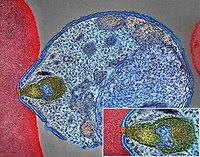
Photo from wikipedia
The persistence of residual infection is one of the major factors in failure of the Global Programme to Eliminate Lymphatic Filariasis (GPELF). The present study aims to explore the status… Click to show full abstract
The persistence of residual infection is one of the major factors in failure of the Global Programme to Eliminate Lymphatic Filariasis (GPELF). The present study aims to explore the status of sheath antibody and regulatory T cells (Tregs) known to play key roles in clearance of parasite and patent filarial infection, in individuals with residual infection after MDA. A total of 61 microfilaremic (Mf) individuals were followed up after at least 6 rounds of MDA. Infection status of subjects was assessed through the detection of Mf and circulating filarial antigen (CFA). Antibodies to Mf sheath were determined by immuno-peroxidase assay (IPA). The expression of Tregs was measured by a flow cytometer. IL-10 and IFN-γ were evaluated using the commercially available ELISA kit. The sheath antibody was present in subjects who have cleared both Mf and CFA and absent in individuals who were found to be Mf /CFA positive. Further individuals carrying infection have significantly high levels of Tregs and IL-10. A positive correlation was observed between Tregs, IL-10, and CFA in infected individuals. In contrast, a negative correlation was observed between IFN-γ and IL-10 in both infected and uninfected subjects. Our study reveals that the absence of a sheath antibody and a high level of Tregs and IL-10 are the hallmarks of the persistence of residual filarial infection.
Journal Title: Immunologic research
Year Published: 2021
Link to full text (if available)
Share on Social Media: Sign Up to like & get
recommendations!